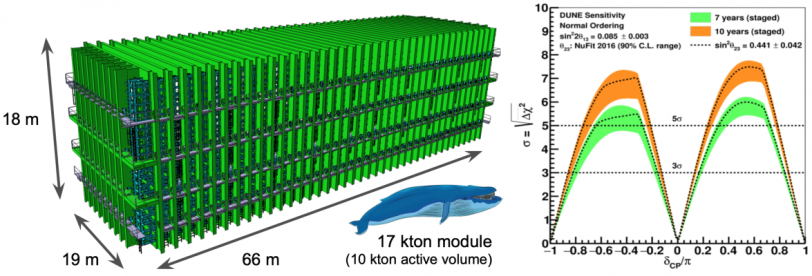DUNE

Deep Underground Neutrino Experiment (DUNE)
DUNE will measure the oscillation probabilities of neutrinos and antineutrinos at unprecedented precision using a high-intensity accelerator neutrino beam and large (10 kton scale) LArTPC detectors placed deep underground in the Homestake Mine. These measurements will give sensitivity to CP violation effects in the lepton sector and may shed light on the matter/anti-matter asymmetry in the universe. In addition, DUNE’s deep underground location will enable searches and measurements of other physics processes, including proton decay, atmospheric neutrinos, supernova neutrinos, and diffuse relic neutrino background.

Far Detector Prototype
The DUNE far detector will operate with the active volume of 40 kiloton liquid argon, which is a huge jump 0.5 kiloton of the ICARUS detector which is the largest LArTPC built and operated to date. The ProtoDUNE Single Phase (ProtoDUNE-SP) detector prototypes the designs of most of the single-phase DUNE far detector LArTPC module components at a 1:1 scale, with an extrapolation of about 1:20 in total LAr mass, and is designed to demonstrate the technology for physics measurements. The ProtoDUNE-SP detector was commissioned at CERN and took a benchmark measurement using a test-beam, for which incoming particles' momentum and type are measured accurately from independent sub-detectors. Physics analysis is on-going to study the capability of the DUNE far detector design for identifying a particle and reconstructing its type and momentum.
SLAC group: is involved in ProtoDUNE-SP for both DAQ electronics and data analysis. For the DAQ, the group integrated and commissioned the Reconfigurable Cluster Element (RCE) platform, a general purpose DAQ system developed in-house by SLAC. A total of 12,800 wire signals from 5 (out of 6) APAs are readout by the RCE system. For data analysis, the group is implementing a machine learning based full data reconstruction chain, also developed at SLAC as a general purpose tool for all LArTPC experiments, for identifying neutral pions and reconstructing its invariant mass for benchmarking the energy reconstruction capability of electromagnetic showers.

Near Detector Prototype
The DUNE near detector (DUNE-ND) will be placed close to the neutrino source and measure an unoscillated neutrino beam for precise measurement of oscillation parameters. Due to intense neutrino flux, dozens of a neutrino interaction are expected to take place within the same image, so called "a neutrino pile-up". A traditional 2D imaging LArTPC detectors will result in notoriously difficult data analysis task due to many particle overlaps. In order to address this challenge, pixel-based LArTPC, which can perform direct 3D imaging and hence reduces particle overlaps in the recorded image pixels, has been designed and demonstrated in a small scale by ArgonCUBE collaboration. This design has been accepted for the official DUNE-ND LArTPC module, and a larger scale prototype is planned following the path of ProtoDUNE-SP. This prototype, called ArgonCUBE 2x2, is expected to be commissioned and start data taking in late 2021.
SLAC group: is heavily involved in the DUNE-ND and ArgonCUBE 2x2 projects in both hardware, software, and data analysis tasks. The group is responsible for the design of a TPC module with a new field cage which will use a high resistivity Kapton sheet. The group is also heavily involved in coordination of software integration with a greater DUNE software environment (i.e. far detector and oscillation analysis), and leads implementation of a machine learning based full data reconstruction chain designed for data analysis.

